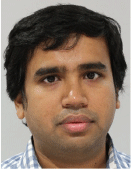Varying least principal stress along lithofacies in gas shale reservoirs: effects of frictional strength and viscoelastic stress relaxation
Partha Pratim Mandal A E , Reza Rezaee A , Mustafa Sari B and Joel Sarout C DA Western Australia School of Mines, Curtin University, Perth, Australia.
B CSIRO Mineral Resources, Perth, Australia.
C CSIRO Energy, Rock Properties Team, Perth, Australia.
D CSIRO Energy, Geomechanics and Geophysics Laboratory, Perth, Australia.
E Corresponding author. Email: p.mandal@postgrad.curtin.edu.au
The APPEA Journal 61(2) 673-678 https://doi.org/10.1071/AJ20064
Accepted: 11 February 2021 Published: 2 July 2021
Abstract
Compositional variation of rock properties in unconventional shale reservoirs impacts not only hydraulic fracturing stimulation but also the variability of induced shear slip on pre-existing fracture networks. Lithological layering is also responsible for varying stress states in various unconventional reservoirs subjected to normal, strike-slip, reverse or hybrid faulting regime (a combination of any two of them). Three possible mechanisms are considered to evaluate the layer-based stress profile in the sub-surface, that is viscoelastic stress relaxation, elevated pore pressure and variation in rock frictional strength. We conducted multistage triaxial deformation tests with varying strain rates (5 × 10−7 to 10−5 s−1) on shale sample originating from three lithological units of the Goldwyer shale formation, that is G-I, G-II and G-III in the Broome platform of onshore Canning basin. Additionally, pore pressure was estimated from wireline logs, and tectonic stress accumulation was modelled using time-dependent deformation (creep) data. The above analysis suggests that varying frictional strength alone could not explain the variation of the least principal stress; however, the inclusion of stress relaxation also contributes, whereas elevated pore pressure has no effect. Using this approach, we could also relate the changes in minimum principal stress (Shmin) from one lithofacies to the other and anticipate how this will impact the optimum design of landing zone during horizontal drilling and completion in unconventional field development.
Keywords: creep, frictional strength, Goldwyer shale formation, stress relaxation, unconventional gas shale, viscoelastic deformation.

Partha Pratim Mandal is a current PhD student at the Western Australia School of Mines (WASM), Curtin University. His research focuses on creating geomechanical workflows to conduct laboratory measurements of the deformation aspect of shale gas, including the viscoelastic deformation, stress partitioning factor of rock composition, multichannel active and passive wave travel time recording and elastic anisotropy. He is also interested in transferring geotechnical skills from the petroleum industry to the green hydrogen storage and monitoring domain. He is the recipient of several scholarships and research grants such as RTP Scholarship, EAGE student fund, PESA Federal Post-graduate scholarship, AAPG Grant-in-Aid and AIG student bursary. He was the founding member and the president of EAGE-SEG student chapter at Curtin University and currently served as a secretary of ASEG, WA branch. He has six years of industry experience as Imaging Geophysicist at PGS both in India and in Australia. He received his first-class BSc degree in Physics (Hons) from the Presidency College, University of Calcutta, India and MSc Tech degree in Applied Geophysics from the IIT (ISM), Dhanbad, India. |

Professor Reza Rezaee of Curtin’s Department of Petroleum Engineering has a PhD degree in reservoir characterisation. He has over 27 years of experience in academia being responsible for both teaching and research. During his career, he has been engaged in several research projects supported by major oil and gas companies, and these commissions, together with his supervisory work at various universities, have involved a wide range of achievements. During his research career, he has led several major research projects funded by various oil and gas companies. He has received a total of more than $2.2M funds through his collaborative research projects. He has supervised over 70 MSc and PhD students during his university career to date. He has published more than 160 peer-reviewed journals and conference papers and is the author of four books on petroleum geology, logging and log interpretation and gas shale reservoirs. His research has been mostly on integrated solutions for reservoir characterisation, formation evaluation and petrophysics. Currently, he is focused on unconventional gas including gas shale and tight gas sand studies. As a founder of ‘Unconventional Gas Research Group’ of Australia, he has established a unique and highly sophisticated research lab at the Department of Petroleum Engineering, Curtin University. This lab was established to conduct research on the petrophysical evaluation of tight gas sands and shale gas formations. He is the winner of the Australian Gas Innovation Award for his innovation on tight gas sand treatment for gas production enhancement. |

Mustafa Sari has a bachelor’s degree in mechanical engineering from the University of Basra, Iraq, in 2009. After his graduation, he worked with Haliburton for 1 year in well-testing department and then he moved to work with Basra South Oil Company in the drilling sector. In 2011, he moved to Australia, where he obtained his master’s degree in petroleum engineering from the University of New South Wales in 2015. In 2019, he obtained his PhD in Geomechanics at School of Minerals and Energy Resources Engineering, UNSW. During his PhD, he has been developing a new multiphysics framework for geomaterials characterisation with multiphysics feedback, through theoretical, numerical and experimental approaches. He has been developing novel constitutive models for sedimentary rocks (sandstone, mudstone, carbonates, shales, clays), incorporating thermal, hydraulic, mechanical and chemical effects. Also, during his PhD, he has received unique experimental training during his visits to some of the best Geomechanics laboratories in Europe (Laboratory 3SR in Grenoble [France], Laboratory of Rocks and Soil Mechanics at KIT [Germany] and Laboratoire NAVIER at Ecole des Ponts ParisTech [France]). In June 2019, he started his postdoctoral fellow position with CSIRO in Mineral resources department. In this role, he is developing a novel non-destructive rock characterisation methodology, in collaboration with multidisciplinary team of researchers including Professor Victor Calo from Curtin University (Western Australia) and Asst. Professor Manolis Veveakis from Duke University (USA), using a multiphysics theoretical and numerical framework based on geomechanical laboratory experimentation. |

Joel Sarout is a Principal Research Scientist at CSIRO in Perth (Australia), where he leads the Rock Properties Research Team. Since 2006, he was involved and led multiple government- and industry-funded research projects to better understand and predicting the effects of anthropogenic subsurface activities in the energy/resources sector, for example O&G exploration and production, CO2 geo-sequestration. Through a science-based approach, these projects have contributed to (i) a more accurate interpretation of 3D/4D seismic and micro-seismicity data; (ii) improving reservoir depletion and borehole stability monitoring/predictions; (iii) optimising exploration for oil, gas and geothermal resources and (iv) enhancing energy resources recovery. He holds an MSc in Civil Engineering from the University of Minnesota (2003) and a PhD in Earth Science (Rock Physics) from the Ecole Normale Supérieure/University Paris Orsay (2006). His technical expertise lies in rock physics, geomechanics and geophysics. He co-authored 53 refereed journal articles, and his work attracted 1590 citations since 2006 (source: Google Scholar). Joel is currently acting as an associate editor for the AGU’s Journal of Geophysical Research-Solid Earth and for the EAGE’s Geophysical Prospecting journal. |
References
DMIRS (2019). Petroleum and Geothermal Information (Wapims). Available at https://www.dmp.wa.gov.au/Petroleum-and-Geothermal-1497.aspx.Jaeger, J. C., and Cook, N. G. (1979). ‘Fundamentals of Rock Mechanics’, 2nd edn. (Chapman and Hall: London.)
Jaeger, J. C., Cook, N. G., and Zimmerman, R. W. (2007). ‘Fundamental of Rock Mechanics’, 4th edn. (Blackwell Publishing Ltd.)
Mandal, P. P., Rezaee, R., and Sarout, J. (2020a). Impact of the stress state and the natural network of fractures/faults on the efficiency of hydraulic fracturing operations in the Goldwyer Shale Formation. The APPEA Journal 60, 163–183.
| Impact of the stress state and the natural network of fractures/faults on the efficiency of hydraulic fracturing operations in the Goldwyer Shale Formation.Crossref | GoogleScholarGoogle Scholar |
Mandal, P. P., Sarout, J., and Rezaee, R. (2020b). Geomechanical appraisal and prospectivity analysis of the Goldwyer shale accounting for stress variation and formation anisotropy. International Journal of Rock Mechanics and Mining Sciences 135, 104513.
| Geomechanical appraisal and prospectivity analysis of the Goldwyer shale accounting for stress variation and formation anisotropy.Crossref | GoogleScholarGoogle Scholar |
Mandal, P. P., Sarout, J., and Rezaee, R. (2021a). Creep behaviour, frictional properties and viscoelastic least principal stress model of Goldwyer shale from deformation experiment at in situ stress – Part II. Rock Mechanics and Rock Engineering Journal , .
Mandal, P. P., Sarout, J., and Rezaee, R. (2021b). Rock strength and Young’s modulus of Goldwyer shale from deformation experiment at in situ stress – Part I. Rock Mechanics and Rock Engineering Journal , .
Singh, A., Xu, S., Zoback, M., and McClure, M. (2019). Integrated analysis of the coupling between geomechanics and operational parameters to optimize hydraulic fracture propagation and proppant distribution. In ‘SPE Hydraulic Fracturing Technology Conference and Exhibition’. (SPE: Texas, USA.)
Sone, H., and Zoback, M. D. (2014a). Time-dependent deformation of shale gas reservoir rocks and its long-term effect on the in situ state of stress. International Journal of Rock Mechanics and Mining Sciences 69, 120–132.
| Time-dependent deformation of shale gas reservoir rocks and its long-term effect on the in situ state of stress.Crossref | GoogleScholarGoogle Scholar |
Sone, H., and Zoback, M. D. (2014b). Viscous relaxation model for predicting least principal stress magnitudes in sedimentary rocks. Journal of Petroleum Science and Engineering 124, 416–431.
| Viscous relaxation model for predicting least principal stress magnitudes in sedimentary rocks.Crossref | GoogleScholarGoogle Scholar |
Xu, S., Singh, A., and Zoback, M. D. (2019). Variation of the Least Principal Stress with Depth and Its Effect on Vertical Hydraulic Fracture Propagation During Multi-Stage Hydraulic Fracturing. Paper presented at the 53rd U.S. Rock Mechanics/Geomechanics Symposium, New York City, New York, June 2019.
Zhang, J. (2011). Pore pressure prediction from well logs: Methods, modifications, and new approaches. Earth-Science Reviews 108, 50–63.
| Pore pressure prediction from well logs: Methods, modifications, and new approaches.Crossref | GoogleScholarGoogle Scholar |
Zoback, M. D., and Kohli, A. J. (2019). ‘Unconventional Reservoir Geomechanics: Shale Gas, Tight Oil, and Induced Seismicity.’ (Cambridge University Press.)


